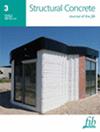Experimental investigation on the tension lap splices used in the joints of precast RC foundation piles
IF 3.3
3区 工程技术
Q2 CONSTRUCTION & BUILDING TECHNOLOGY
引用次数: 0
Abstract
The joints between precast reinforced concrete pile segments in deep foundations are typically mechanically lockable. They include anchor bars embedded inside the ends of each segment, forming lap splices with the main bars. Because of their particular technology, these lap splices are somewhat different from traditional lap splices, as shown in the first part of this paper, where the impact of their specific characteristics on the tensile behavior of the joints is discussed. The experimental section presents the results of 19 tensile tests on these lap splices and compares them with established theoretical models. The roles of various parameters (lap length, type and amount of confining reinforcement, type of anchor bars, and concrete cover thickness) are investigated. One of the major findings indicates a significantly lower lap capacity when using plain‐bar spirals compared to closed‐ribbed stirrups. Additionally, at low stress levels, the models tend to be unconservative. Building on this insight, a modified model is proposed for lap splices provided with plain‐bar spirals.预制钢筋混凝土基桩接缝中使用的拉力搭接接头的实验研究
深基坑中预制钢筋混凝土桩段之间的接缝通常是可机械锁定的。它们包括嵌入每个桩段两端的锚固钢筋,与主钢筋形成搭接。正如本文第一部分所述,由于其特殊的技术,这些搭接接头与传统的搭接接头有些不同,本文将讨论其特殊性对接头抗拉性能的影响。实验部分介绍了对这些搭接接头进行的 19 次拉伸试验的结果,并将其与已建立的理论模型进行了比较。研究了各种参数(搭接长度、约束钢筋的类型和数量、锚固钢筋的类型以及混凝土覆盖层厚度)的作用。其中一项主要研究结果表明,与闭肋箍筋相比,使用平筋螺旋箍筋时,搭接能力明显较低。此外,在应力水平较低时,模型往往不够保守。在此基础上,针对使用普通螺旋箍筋的搭接接头提出了一种改进模型。
本文章由计算机程序翻译,如有差异,请以英文原文为准。
求助全文
约1分钟内获得全文
求助全文
来源期刊

Structural Concrete
CONSTRUCTION & BUILDING TECHNOLOGY-ENGINEERING, CIVIL
CiteScore
5.60
自引率
15.60%
发文量
284
审稿时长
3 months
期刊介绍:
Structural Concrete, the official journal of the fib, provides conceptual and procedural guidance in the field of concrete construction, and features peer-reviewed papers, keynote research and industry news covering all aspects of the design, construction, performance in service and demolition of concrete structures.
Main topics:
design, construction, performance in service, conservation (assessment, maintenance, strengthening) and demolition of concrete structures
research about the behaviour of concrete structures
development of design methods
fib Model Code
sustainability of concrete structures.
 求助内容:
求助内容: 应助结果提醒方式:
应助结果提醒方式:


